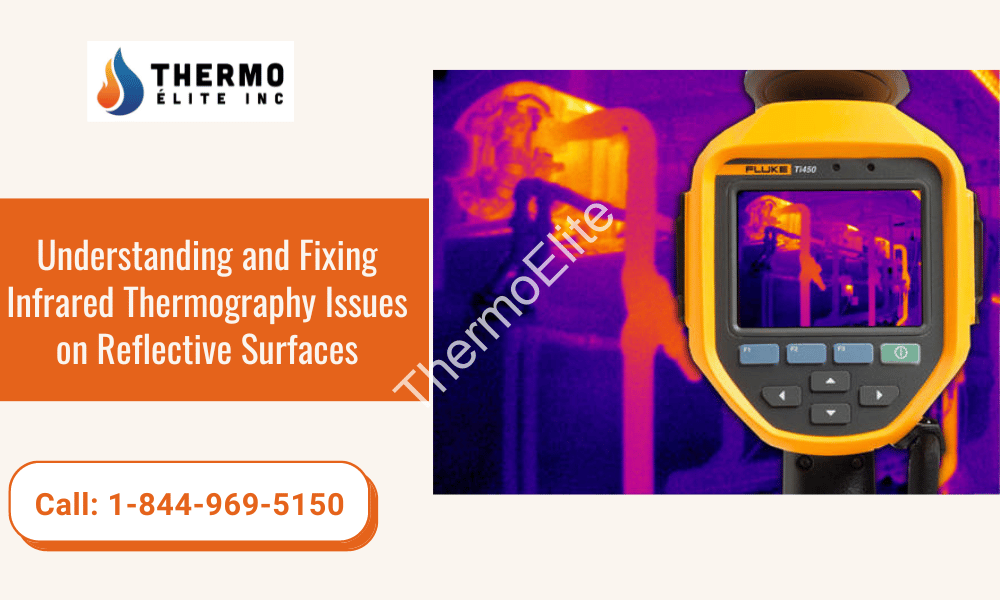Amongst a variety of heat transfers, radiation is at the top of the list when it comes to thermography. The mode of energy transfer from the surface that’s been targeted to the infrared camera is radiation. The radiation a surface emits or reflects almost entirely decides the content visible to you in a thermal image. All target surfaces have issues regarding thermography emissivity and reflectivity whatever the application—aerospace, buildings, industrial, medical, etc.
If you were to observe thermal images of stainless-steel items with your naked eyes, there’s every possibility that you would conclude that the entire object bears the same temperature. You would feel it’s no different from the temperature of the air surrounding it. However, in reality, the images try to say something else. Let’s look into the issues.
Inefficiency in Emission of Reflective Surfaces
It’s obvious that reflections are present. However, there are changes in the way an object reflects when we move positions. There are changes in the apparent temperature on the steel surface as well. You may interpret the cold areas as representing the sky above while the warmer areas are a representation of the buildings surrounding the place and even yourself. We call these misleading reflections “thermal lies” since what’s true about reflective surfaces is them being inefficient transmitters.
How to Read the True Temperature
You’ll find it quite easy to differentiate reflected radiation from radiation that’s emitted. When you move relative to the targeted surface, the reflected radiation moves as well just as it does in a mirror. You only quantify the radiation generating the thermal image when you measure radiometric temperatures. So, how do you measure the actual temperature of the object being inspected instead of ending up merely quantifying the emitted radiation?
Due to its calibration, thermal imagers correlate the temperature they capture with radiation intensity of a certain degree. Only knowing how much radiation a surface emits would have told you its temperature if the surface emitted heat perfectly. The radiation would be higher if the temperature were so. Unfortunately, no surface is a perfect emitter of heat.
The Conflict between Surface Emissivity and Reflectivity
A mix of reflected and emitted radiation is produced by all opaque surfaces. Since there’s no relation between surface temperature and radiation, you must have your imager ignore that portion of the image. To do so, you’ll have to correct E (emissivity). R (reflection) is equal to 1 minus E. The reflected temperature shall have to be corrected as well. Once you have made these two corrections, you can have the imager’s processor give an accurate radiometric temperature.
In the following two situations, this correction may not be as accurate as you would want it to be:
- The emissivity of the targeted surface is below 0.6
- There’s a marked difference between the surface temperature and the reflected temperature
All thermal imaging systems come with this limitation. Therefore, it’s not possible measuring the temperature of most bare metals accurately. You can however overcome this shortcoming.
How to Raise Accuracy on Reflective Surfaces
Apply a small piece of electrician’s tape firmly to the surface you are testing so you can achieve accuracy of a high level while measuring the temperature of surfaces with low emissivity. Be sure to follow the necessary safety requirements. The thermal imager shall have to be set to an emissivity degree of 0.95. You’ll also need to set the background correction to the temperature the tape would reflect if it were a mirror. Follow this process so you can achieve a +/-2 degree Centigrade measurement accuracy, i.e. 2% of the recorded measurement.
You may carry out a few experiments in your kitchen or office until you get a hang of making these adjustments. It’ll help raise your confidence as well.
Testing Techniques of Infrared Thermography
To achieve accurate results, you must know the infrared thermography testing techniques. You may choose from several testing options. Which option you consider should depend on various factors including the set of data you seek and the surface you are monitoring. Here are a few techniques used commonly
- Active Thermography: In this technique, to create temperature differences in the surface affected by the interior material, you’ll need an external energy source. You’ll be able to show the flow of heat through the surface so you can locate the abnormalities in the object while it’s being used.
- Passive Thermography: In this method, you take the images while you are still running the machine or right after you have run it. This way, you won’t need to use any external source of energy while gathering data. Neither will you need to take the machine offline.
- Vibrothermography: Vibrothermography can locate cracks in the object being tested. This is done by the introduction of acoustic waves into the object you are testing. There’s friction between the crack’s rough edges on either side caused by the acoustic energy’s disturbance. The heat thereby produced is captured by the infrared camera.
- Lock-in Thermography: This method involves an external energy source being applied to the surface being tested that reveals the anomalies beneath the surface. You need to know the material’s makeup and properties to achieve accuracy in this method. You must also know the location and the size of the anomaly. This method takes longer than the others, but it’s suitable for penetrating objects that have thicker walls.
Conclusion
Achieving accuracy in reading thermography results can be a tricky affair. It’s more so when you are dealing with reflective surfaces. Reflective surfaces being inefficient transmitters create problems. We have discussed methods that help you work around the challenges posed by reflective surfaces. These methods combined with your skill and experience can help you read the thermal images of these surfaces accurately. We have also shared techniques that can help you achieve accuracy in reading thermography results of reflective surfaces. The various methods of thermography are discussed as well so you can gauge which method suits your needs perfectly.



